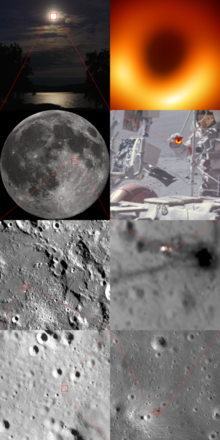Angular resolution
ability of any image-forming device to distinguish small details of an object
Angular resolution is using image-forming device to get small details of an object. This can increase the image resolution of the image. It is used in optical or radio telescopes, microscopes, cameras, and eyes. In optics, it is used for light waves. In antenna theory, it is used for radio waves. In acoustics, it is used for sound waves.

An optical system can have a high angular resolution. This means that the perceived angular distance, (or what the viewer thinks the angular distance is) or the actual angular distance between the objects is small.
θ is the amount of angular resolution. An angular resolution can be found from the Rayleigh criterion.
Telescopes and angular resolution
change| Name | Image | Angular resolution (arc seconds) | Wavelength | Type | Site | Year |
|---|---|---|---|---|---|---|
| Global mm-VLBI Array (successor to the Coordinated Millimeter VLBI Array) | 0.000012 (12 μas) | radio (at 1.3 cm) | very long baseline interferometry array of different radio telescopes | a range of locations on Earth and in space[1] | 2002 - | |
| Very Large Telescope/PIONIER | 0.001 (1 mas) | light (1-2 micrometre)[2] | largest optical array of 4 reflecting telescopes | Paranal Observatory, Antofagasta Region, Chile | 2002/2010 - | |
| Hubble Space Telescope | 0.04 | light (near 500 nm)[3] | space telescope | Earth orbit | 1990 - | |
| James Webb Space Telescope | 0.1[4] | infrared (at 2000 nm)[5] | space telescope | Sun–Earth L2 | 2022 - |
Related pages
changeReferences
change- ↑ "Images at the Highest Angular Resolution in Astronomy". Max Planck Institute for Radio Astronomy. 2022-05-13. Retrieved 2022-09-26.
- ↑ de Zeeuw, Tim (2017). "Reaching New Heights in Astronomy - ESO Long Term Perspectives". The Messenger. 166: 2. arXiv:1701.01249.
- ↑ "Hubble Space Telescope". NASA. 2007-04-09. Archived from the original on 2022-09-24. Retrieved 2022-09-27.
- ↑ Dalcanton, Julianne; Seager, Sara; Aigrain, Suzanne; Battel, Steve; Brandt, Niel; Conroy, Charlie; Feinberg, Lee; Gezari, Suvi; Guyon, Olivier; Harris, Walt; Hirata, Chris; Mather, John; Postman, Marc; Redding, Dave; Schiminovich, David; Stahl, H. Philip; Tumlinson, Jason (2015). "From Cosmic Birth to Living Earths: The Future of UVOIR Space Astronomy". arXiv:1507.04779 [astro-ph.IM].
- ↑ "FAQ Full General Public Webb Telescope/NASA". jwst.nasa.gov. 2002-09-10. Archived from the original on 2023-10-14. Retrieved 2022-09-27.
Other websites
change- "Concepts and Formulas in Microscopy: Resolution" by Michael W. Davidson, Nikon MicroscopyU (website).